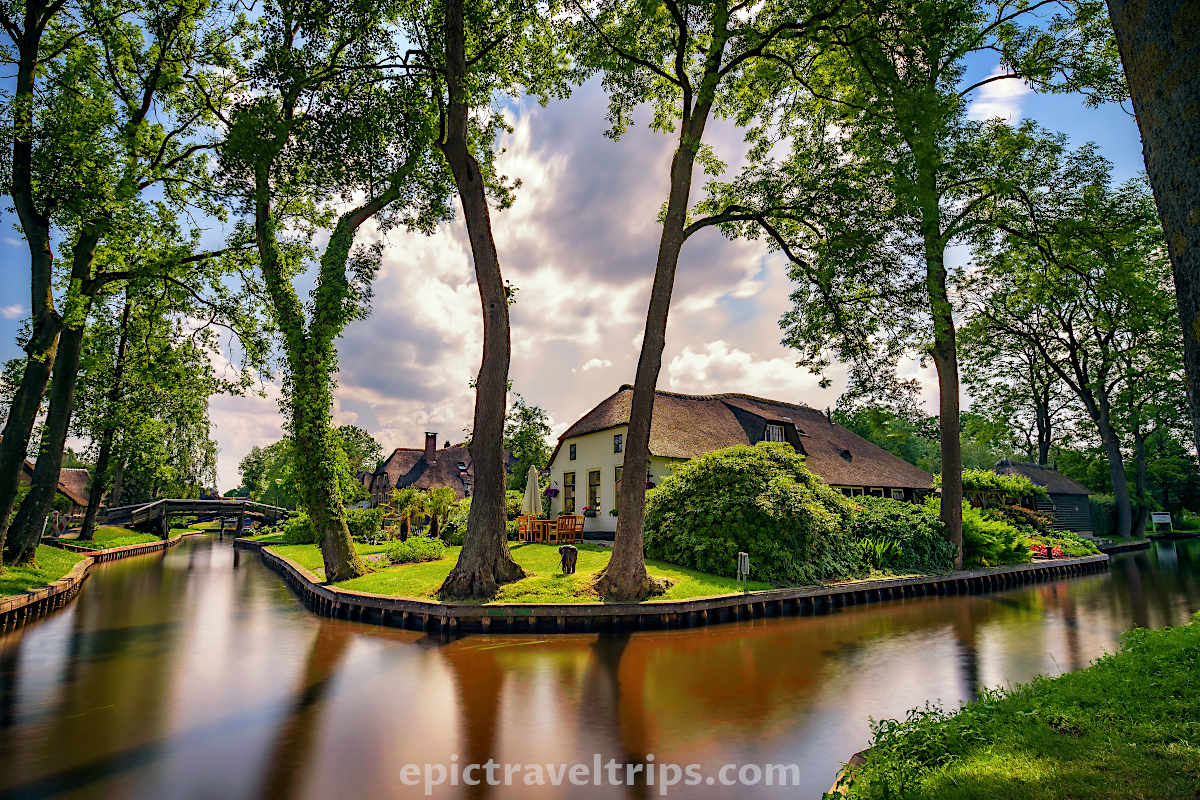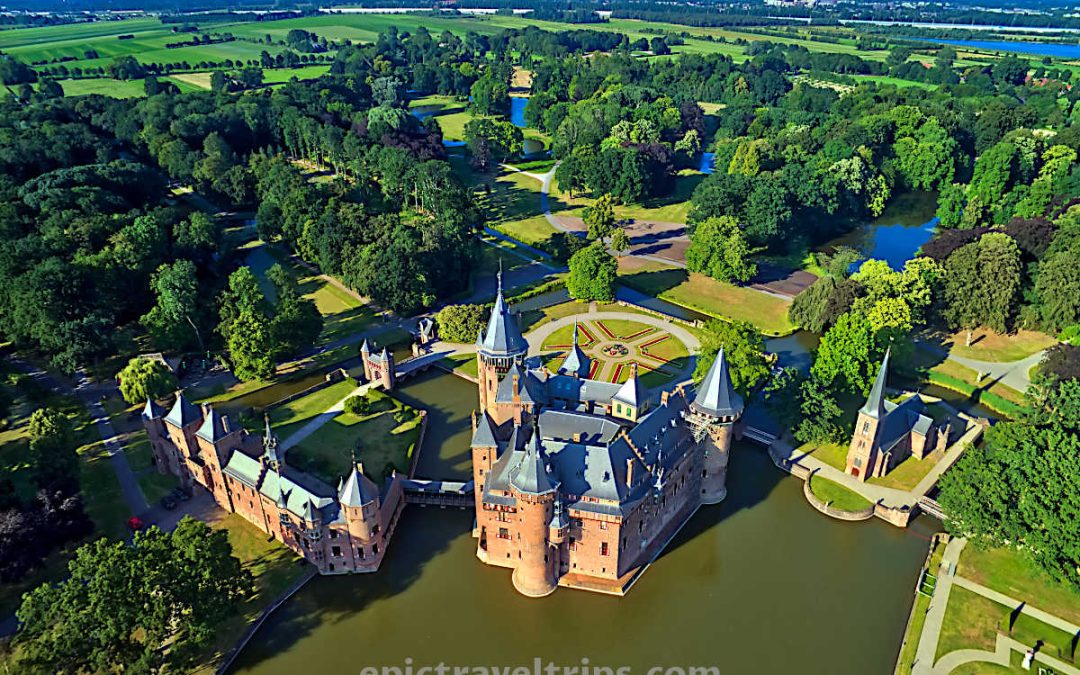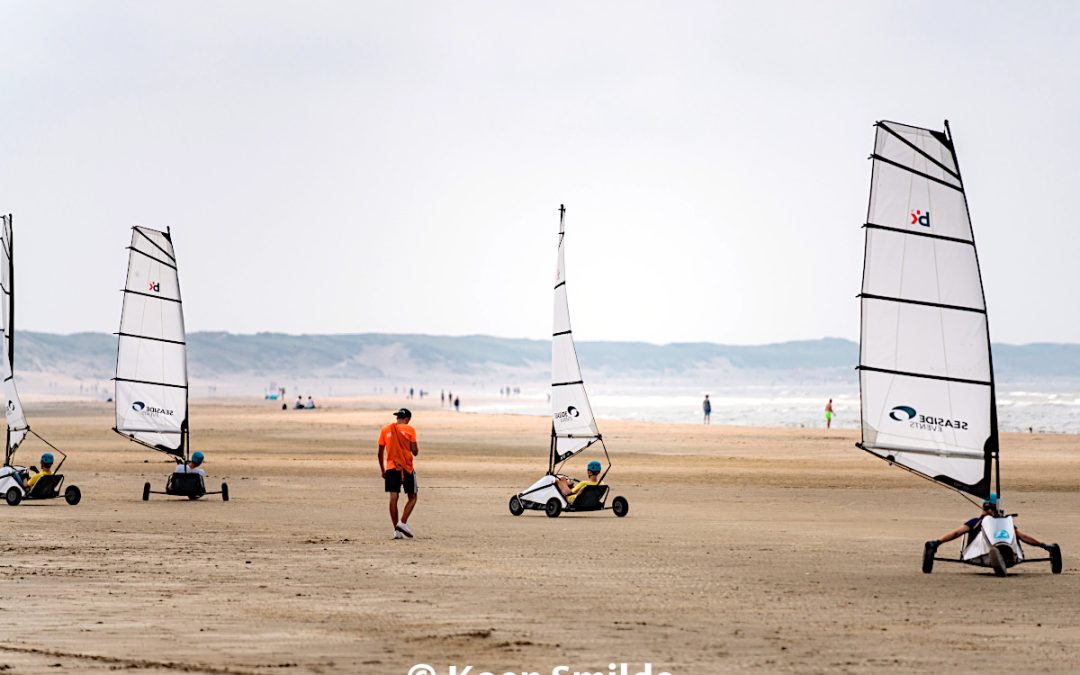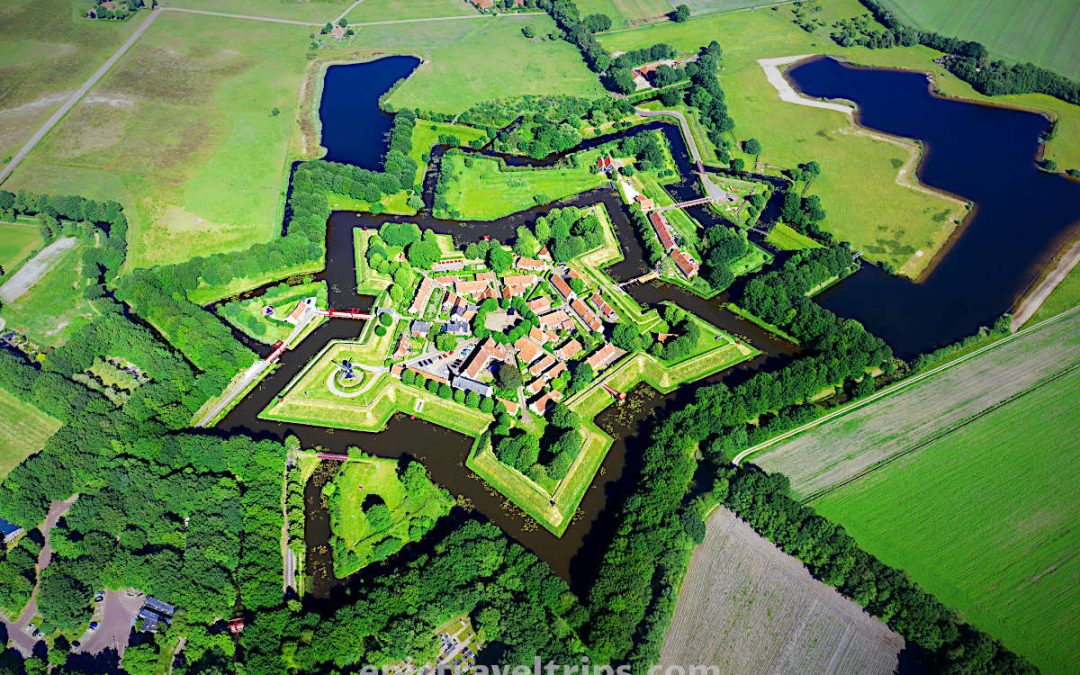- What Is Giethoorn
- What To See
- Where is located?
- How To Reach?
- How Long Does It Take?
- Where To Park?
- When Is The Best Time To Visit?
- Where To Eat?
- Where To Stay?
- What Is Nearby?
- Giethoorn – Our Impressions
What Is Giethoorn
Geithhoorn is a small village in The Netherlands. You might ask, well ok, but why this small village is so famous and worth visiting & writing about it? So nice of you to ask about that. The discoveries, activities, and necessities of people living and working here shaped life in the village. It is so unique.
A network of canals crisscross Geithoorn and connect lakes and larger canals into a unique labyrinth on the water. The villagers built their thatch-roofed homes on small islands with slightly higher ground. It protects houses from floods and emphasizes them from the waterfront.
Around the houses are small gardens with colorful flowers and grass. Chickens happily run around looking for worms in some yards. Or, in our case, to amuse us, curious tourists. Homeowners use small wooden bridges to cross the canals, so they can step on their small islands’ yards and enter the premises.
We made a Google Map that we share with you. So you can easily navigate attractions, parking lots, and boat tours in Giethoorn.
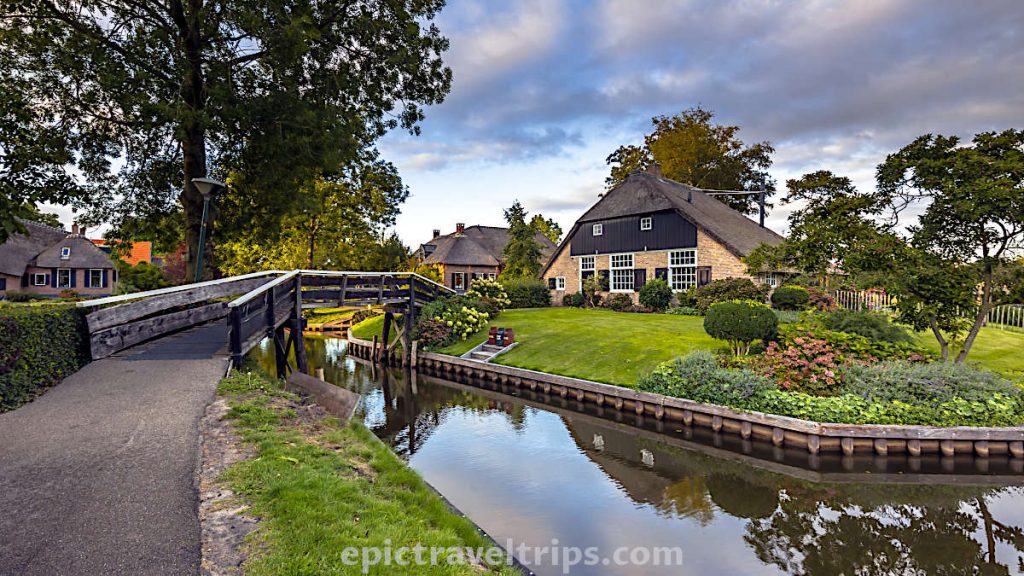
Giethoorn History
While taking the guided tour, our guide pointed out that the lake was artificially created by peat digging done by the settlers. This peat activity in puddles and lakes drove the establishment of transportation over the water. The punts (described later in this article) were suitable boats for transporting peat, cattle, harvest, etc. Thus, canals and ditches were more important than roads. The peat treatment shaped the whole architecture, life, and settlement building.
We present some old photos that we found on the Giethoorn Museum website. Therefore, you can sense how life was back in the day. In the photo below, we can see peat diggers.

After all these pieces of information, finally, we can connect all the dots in logical order:
- Settlers discovered the peat and realized its value.
- They started digging it.
- As a consequence of this digging activity, smaller puddles become lakes.
- The best way to transport something on the water is by floating vessels.
- Thus, the settlers mastered the building of various punt boats.
- Since water transport was the predominant mode of transport, canals, and ditches were the primary network infrastructure.
- A Maze of canals drove to building houses on small islands.
- The villagers constructed bridges to connect these houses on islands.
- Such infrastructure maintained the water and land transport capabilities in the settlements.
We discovered some astonishing facts when we visited Kasteel de Haar (De Haar Castle) near Utrecht a few days later. The castle used peat as the fuel for the central heating system. The peat was coming from Giethoorn, maybe.

Giethoorn – Origin Of The Name
The first inhabitants of this region settled around 1200. While cultivating the land, they found many horns of wild goats which drown in the previous floods, especially the one from 1170. So they called their settlement “Geytenhoren” (Goathorns), which eventually evolved into “Giethoorn”.
We mentioned the fact that we found many Dutch words similar to Norwegian. So we would like to point out these similarities.
“Green Venice”, “Venice of The Netherlands”, and “Dutch Venice” are just a few well-known nicknames for Giethoorn. After this short introduction, let’s discover and explore the village.

Giethoorn Village – What To See
We arrived at Giethoorn from Fort Bourtange at the Dutch-German border. We tried our luck looking for a parking lot in the center, and we were happy to find a free spot on Yellow P2 parking near the Plus grocery shop. The parking is free but more about that in the dedicated section “Where To Park”.
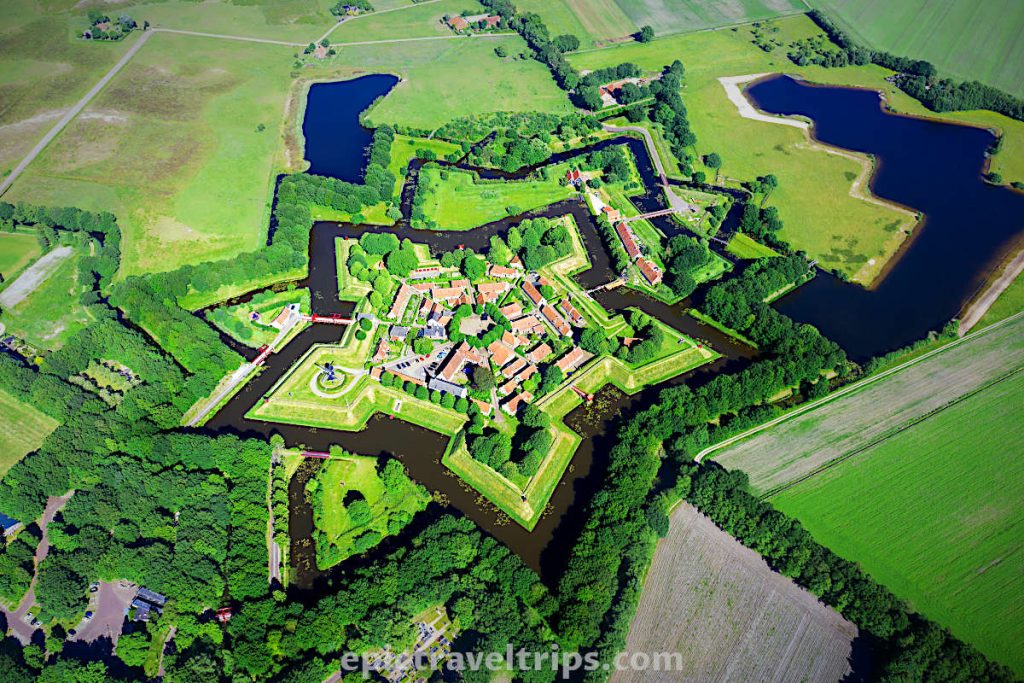
We stumbled upon the tourist information container office on our way to the canals. Here we got a few brochures and extra info about what is worth seeing and doing in Giethoorn.
We made a Google Map that we shared with you. So you can easily navigate attractions, parking lots, and boat tours in Giethoorn.
1 – Vessel Of Choice
Now it was on us to decide how we want to explore the canals in Giethoorn. We had several options. The first option was presented in front of our eyes since the young Dutch instructor was giving a crash course to young boys from India on how to operate a so-called “whisper” boat. Such an open boat has silent electrical, user & environmentally friendly (read: uncomplicated to operate) motor. Later, we discovered that not everyone manages the vessels, and sometimes crashes and water incidents happen, but about that in a few minutes.
The second option was to rent a canoe and paddle ourselves.
The third option was a guided tour in the covered wooden boat.
The fourth option was punting traditional punt boats, described in the next section.

Since I drove for the last two days more than 1 300 km (800 miles) from Oslo (Norway), Olive Oyl (my wife) relieved me from duty to be her Popeye The Sailor. She opted for Captain Sparrow, and we should take a guided tour. Our Young Jedi (our son) and I couldn’t agree more to be pirates of the Giethoorn and go for “plunder” in the canals. After all, we are “Vikings” from Scandinavia. But, as soon as we boarded the boat, the police showed up, and our dream of piracy returned us to reality. Arrrgh!
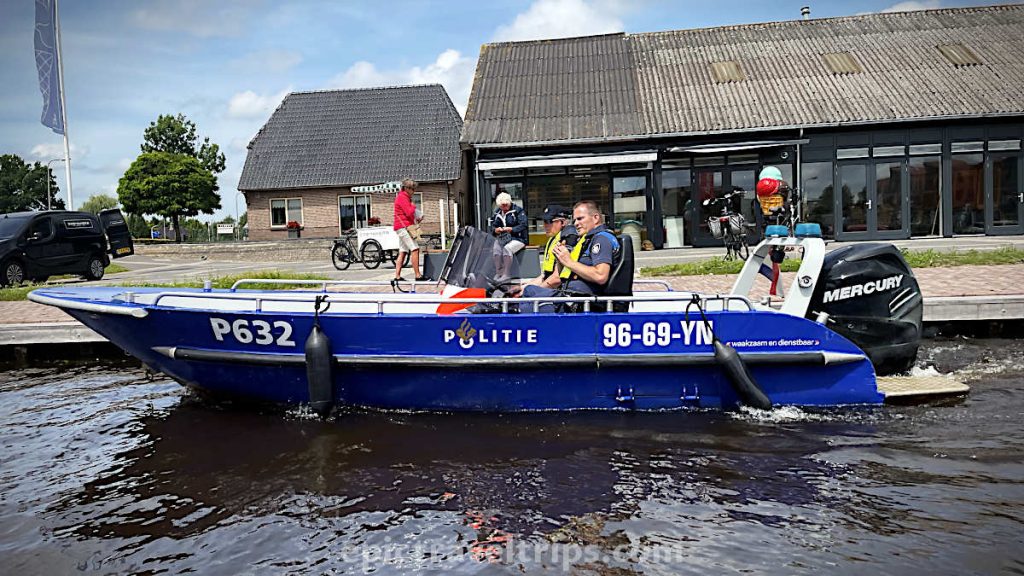
However, we found some extraordinary treasures. Pirates of Confusion are ready for an adventure.
2 – Punts (Punter) – Flat-Bottomed Work Boats
In all seriousness, many used traditional punts as the usual mode of transportation for centuries. A punt is a collective name for open flat-bottomed boats.

Characteristics of punts are that they have an almost flat lanceolate surface, straight, strongly inclined stems, and angular frames designed for use in small rivers or canals and shallow waters. The punter (boat “driver”) propels the punt by pushing against the river bed with a long pole.
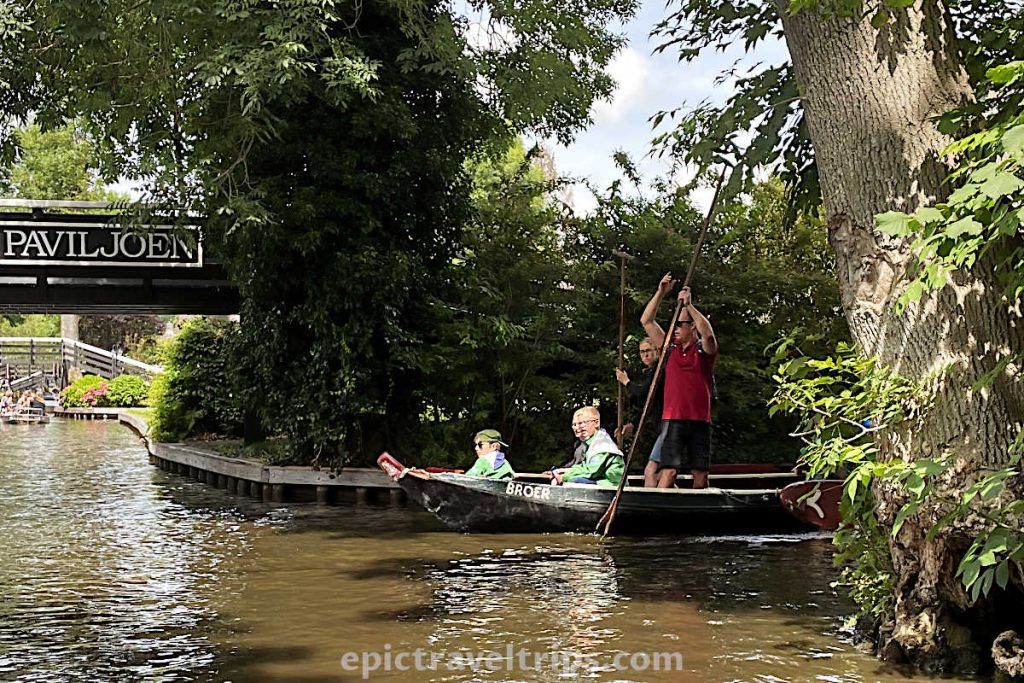
We found some old drawing design plans of various punt boat sizes.
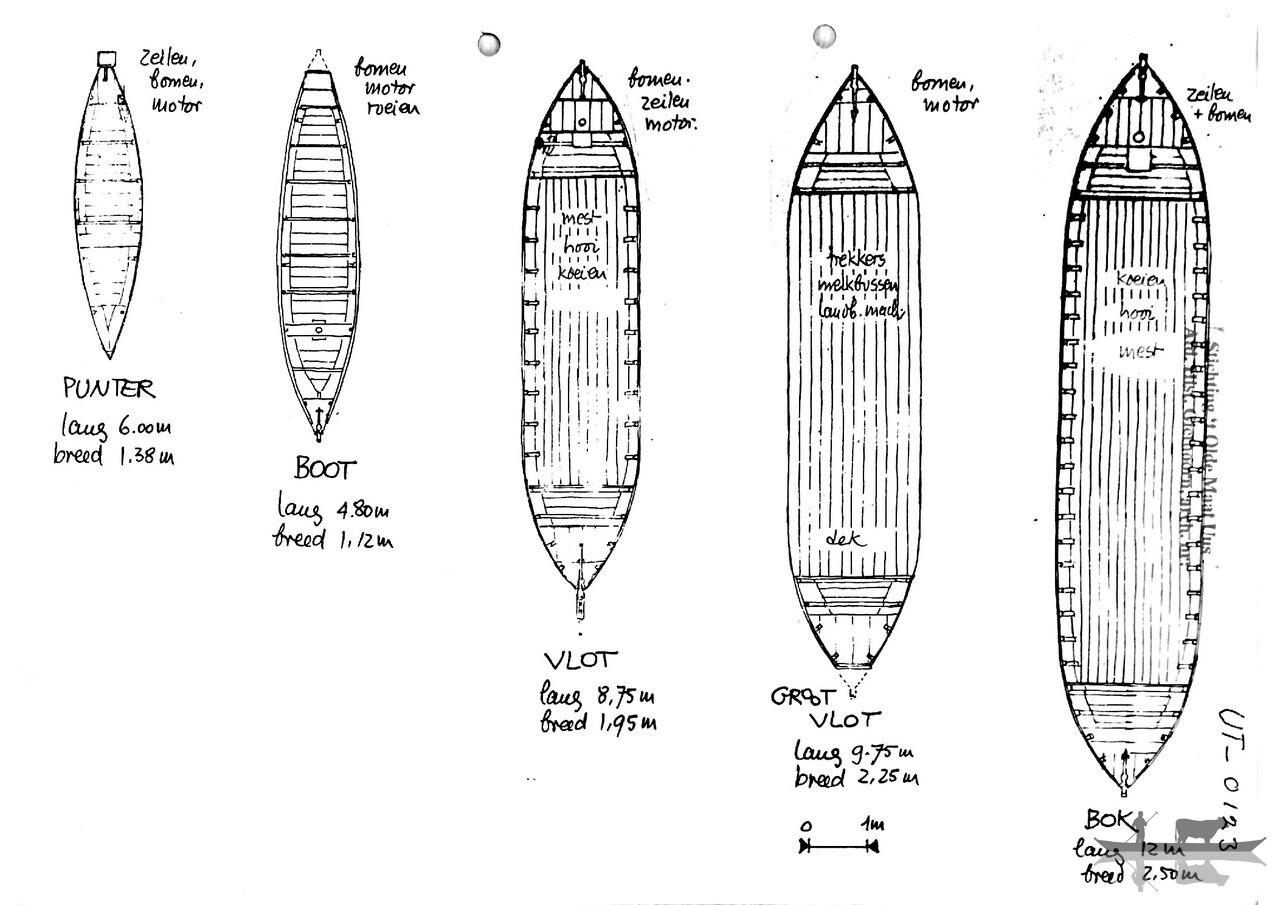
3 – Guided Tour In Covered Boat
One-hour guided tour on the covered boat for € 30.00 for the three of us sounded like a good deal. We hopped in on one of the boats and were excited to depart on our voyage. The boat slowly and smoothly floats, so we had plenty of time to enjoy the scenery from a water perspective and take photos simultaneously.
Soon, the boat turned left and joined the convoy of smaller vessels, canoes, punts, and cruise boats. The traffic slowed down since there was a jam in front, but that was even better since we had more time to grasp the beauty around us to the full extent.

In front of one of the houses, we have seen a whole family playing in the grass yard. That confirms the fact that real people are living here and around two thousand inhabitants.

Giethoorn Houses – Description
The houses are beautiful. Brick-layered walls, thatch roofs, and carved windows on the roof are recognizable features of Dutch countryside architecture. Massive windows with dark raised panel shutters contrast with white window frames are also noticeable. Some windows shutter have cut-outs of different shapes. Diamond or heart shapes are popular ones. The wooden pillars and boards hold and protect the garden and house island from boats passing by.
The gardens are the frames, and the houses are the canvas of a beautiful painting. Some dwellings have nicely trimmed grass, colorful flowers, trees, and benches. Some even have kayaks as advertisements for boat rental businesses.

The heroes were a couple of sweet and calm black hens. They were so cute and doing their things while posing for us for mesmerizing photos.
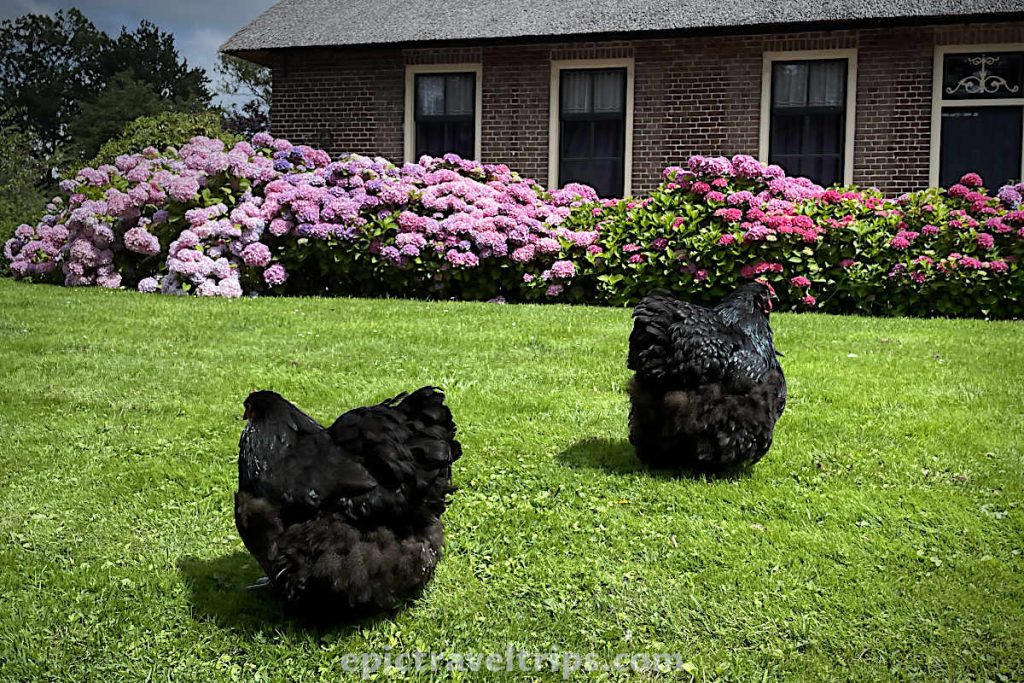
Giethoorn Houses As Businesses
Some houses are small businesses. Like the one, we mentioned for renting boats, kayaks, etc. Others were art potteries, small bakeries, or selling ice creams. We noticed Rhoda Pottenbakkerij, M.S van den Heuvel boat rental, Floramics Art Pottery, etc.

The boat turned right to Smiths Pavillion restaurant. After the restaurant, the cruiser entered the lake. Over the lake was open terrain and a little bit windy. The houses on the lake’s bank are more modern but less attractive to those within the canals. After quick sightseeing of the lake, the boat returned to the canal’s maze. So we saw even more houses. We took a photo of one family fishing from their island. Another confirmation that people do live in Giethoorn village.
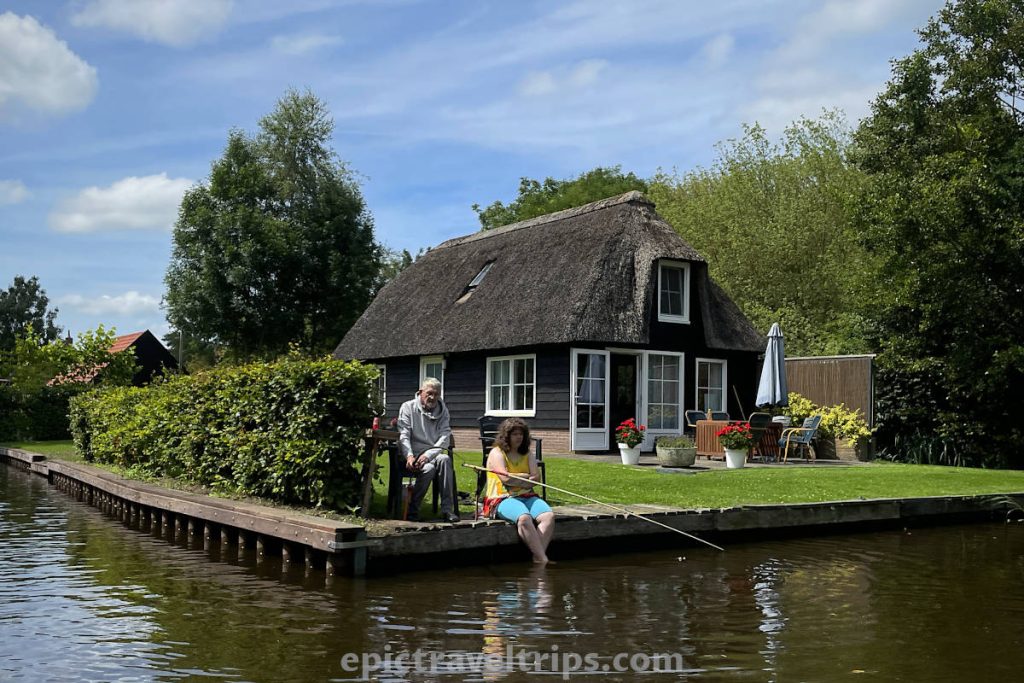
The tour was impressive, and we are highly recommending it to everyone. Yet, we noticed that not everyone followed the rules of boat traffic or was skillful in steering the boats.
Giethoorn Canal Markers & Tips
To have a pleasant boat or canoe tour, we believe that if you follow the rules, you will be more than happy and have fun.
Here are a few tips:
- Always go with the flow, which means do not steer your boat in the opposite direction on a one-way canal unless the canal is two ways.
When you approach the junction, watch for the traffic signs (canal signs are different than road signs):
- blue rectangular sign with white arrow points in which direction you should drive your vessel
- red rectangular sign with a white horizontal stripe in the middle means do not turn into that canal since the traffic is from the opposite direction
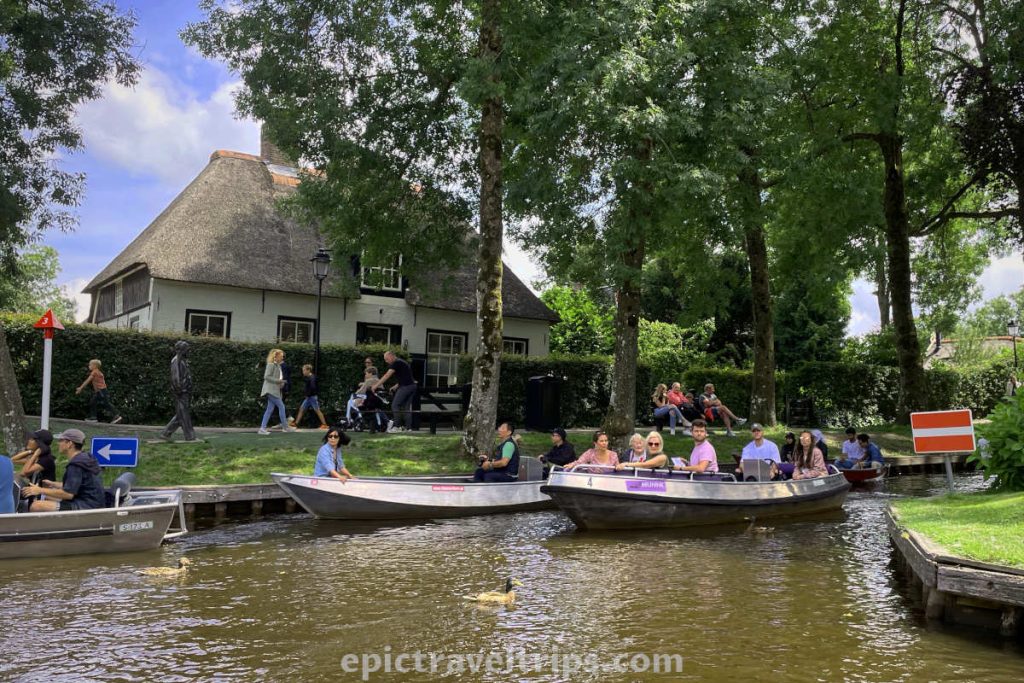
- a blue square sign with a white cross means there is a cross-section and you can expect traffic from all directions, a thicker line means traffic with higher priority.
- On the busiest cross sections, there are mirrors. Use them to see the traffic around the corner and control your speed.

Do not crash into bridge pillars since they can damage the bridge and the owner needs to fix it at a pricy expense.
4 – Walking In Giethoorn
After we finished the boat tour, it was time to repeat the walk on the best parts of the canals. So we walked along the longest canal and crossed several bridges. We took photos from a bit higher perspective compared to the water level. A few minutes ago, we watched the pedestrians from the boat, and now we switched roles and watched people enjoying their floating rides.
The advantage of walking compared to a boat tour was that we didn’t need to worry about the traffic. We could stop anytime we wanted and enjoy the scenery or take photos as much as we wanted to.
We have even experienced one gentleman jumping into the canal and searching for a lost mobile phone.
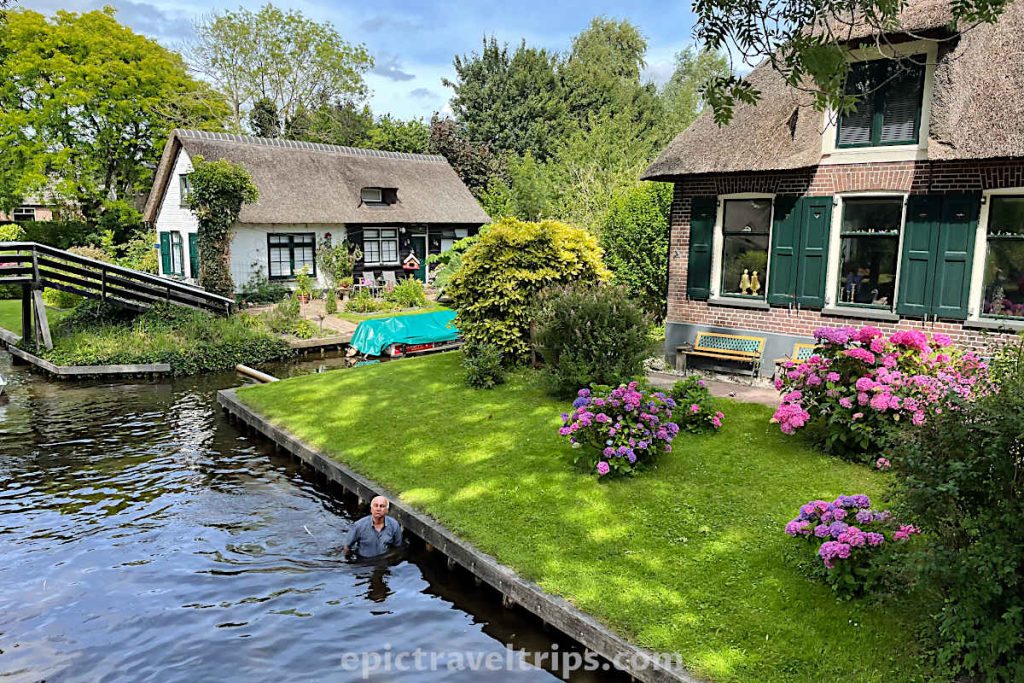
5 – Museum Giethoorn ‘t Olde Maat Uus’
The museum is like a time machine bringing us back into the past. Here is possible to see the inside of an authentic farmhouse and how life in Giethoorn village used to be. We could get more info about various tools and techniques used in peat digging.
The Museum Giethoorn ‘t Olde Maat Uus is new and recently redesigned. The personal stories of striking residents reveal all kinds of things about peat extraction and folk customs. You can see the inside of an authentic farmhouse only here. The fisherman’s cottage and the boathouse also give a unique impression of life in days gone by.
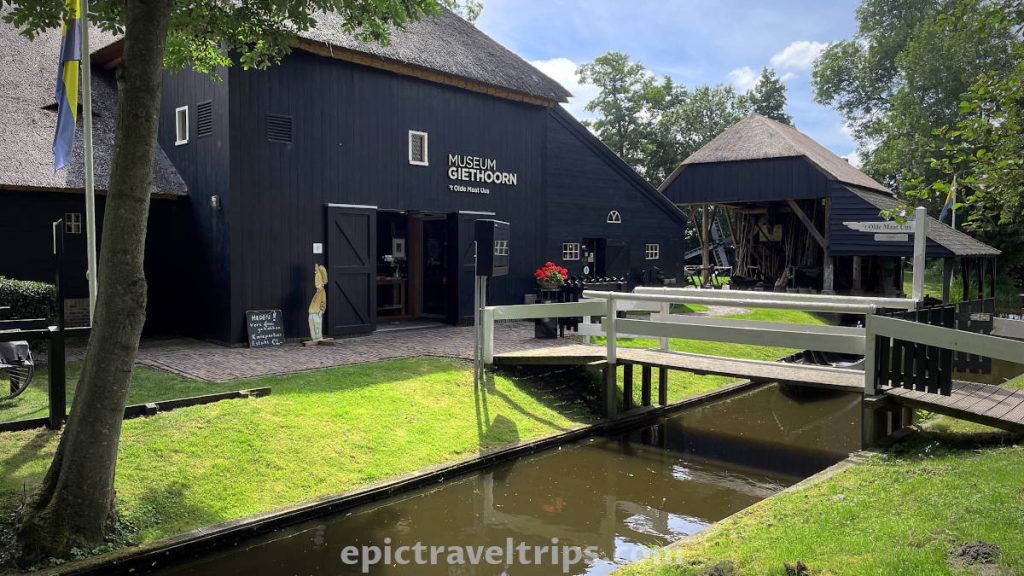
Old Giethoorn Photos
We found several old photos from the museum image bank, so we all can sense how life in the past was.
Building of punt boats in the old days.

Thatch roofs house building technique.
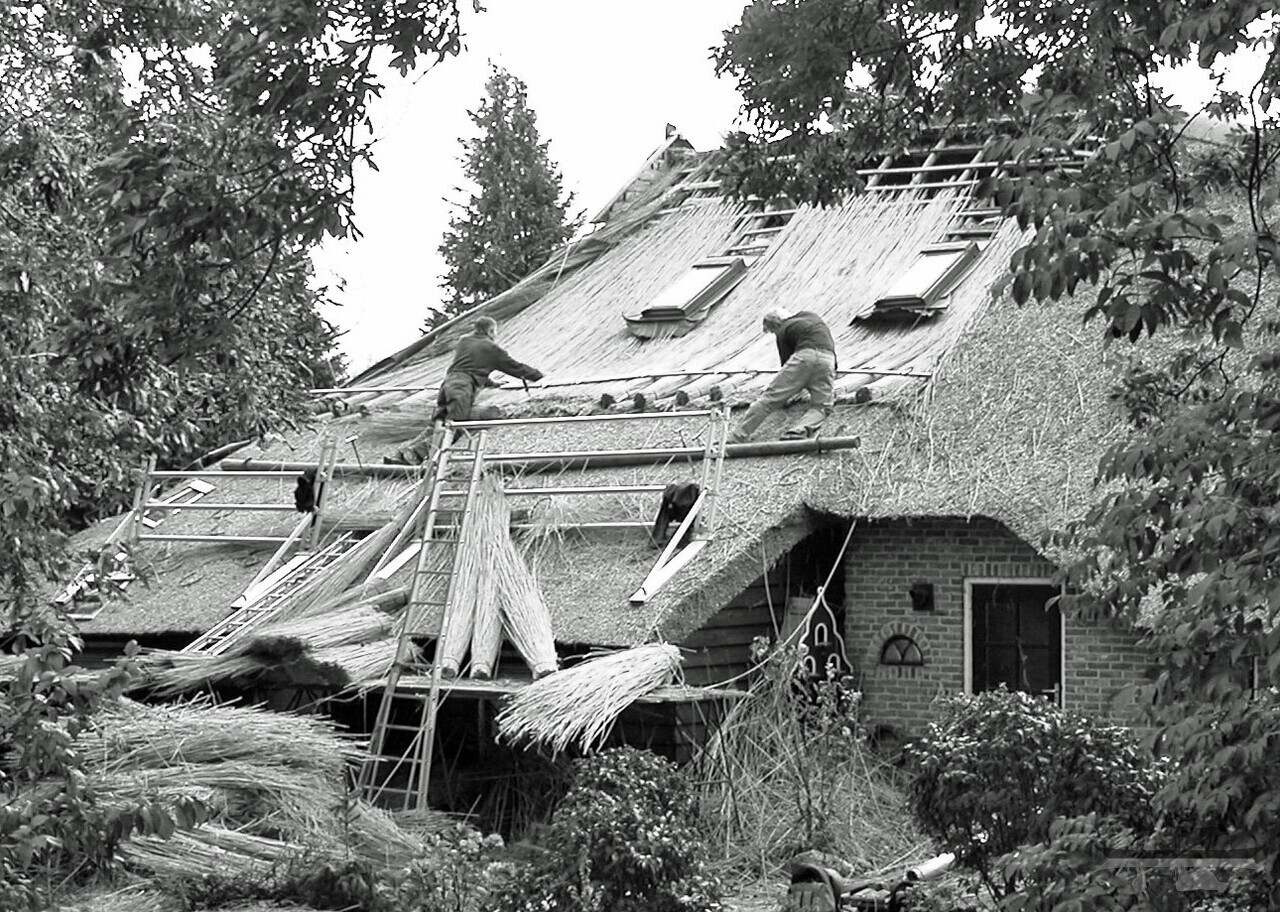
Transport of milk and dairy products by punt boats.
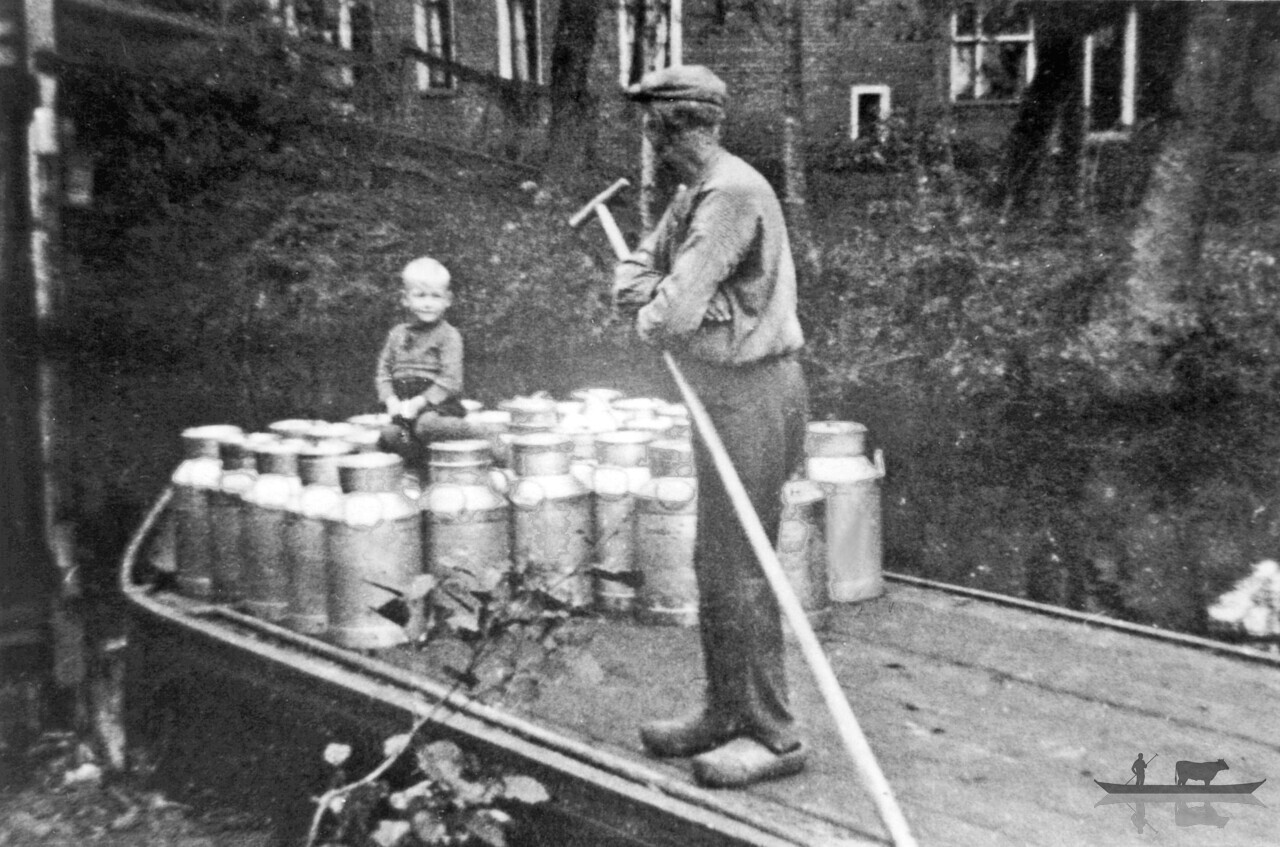
6 – Giethoorn Beautiful Houses
Architecture in the countryside is very different from the city architecture in Holland. Amsterdam is a typical Dutch representative of city architecture with high narrow brick buildings and steep roofs.
Giethoorn houses are a countryside type of Dutch architecture. Thatch roofs houses with colorful gardens on peat islands connected with wooden bridges are the best description of the style.
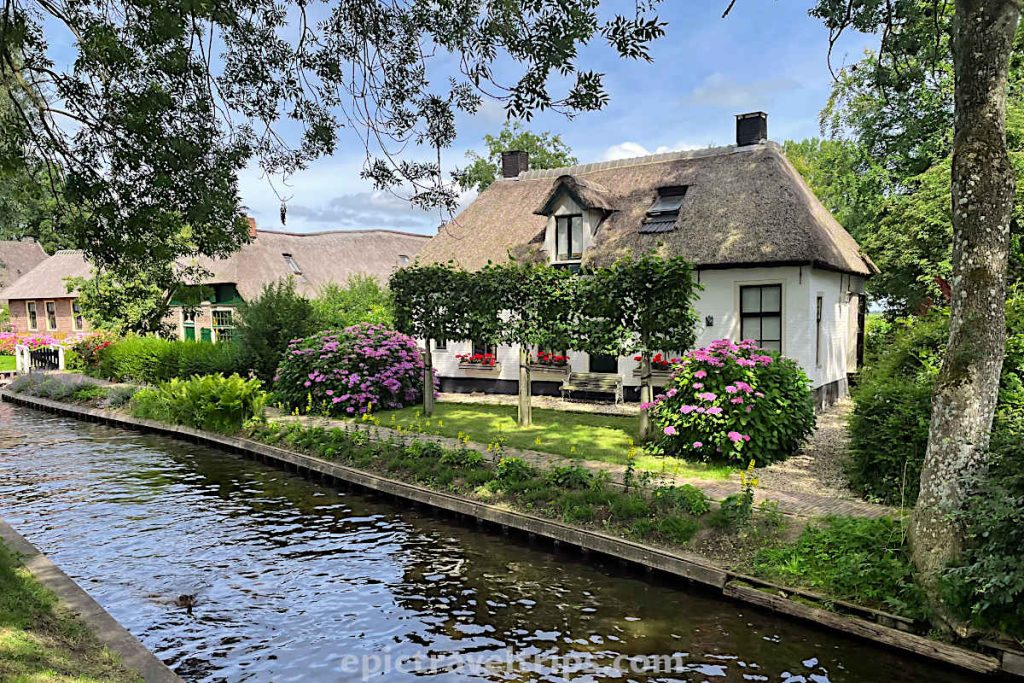
Houses near the church are noticeably beautiful, and we took extra time to enjoy ourselves and take photos. Another place with eye-catching houses is near M.S van den Heuvel boat rental.

7 – Mennonite Church Giethoorn
Mennonite Church in Giethoorn is next to the museum and has long been a seat of a Mennonite congregation. The settlers built the church in 1871. The entrance is free and open from 13:00-17:00

8 – Giethoorn Floramics
Art pottery Giethoorn Floramics is a short walk from the center along the famous and beautiful village canal. The studio is in a former stable of a 100-year-old typical Gieterse farm. We passed by it both on boat and walk tours.

Some pieces reminded us of the Desert stone rose souvenirs from Tunisia.
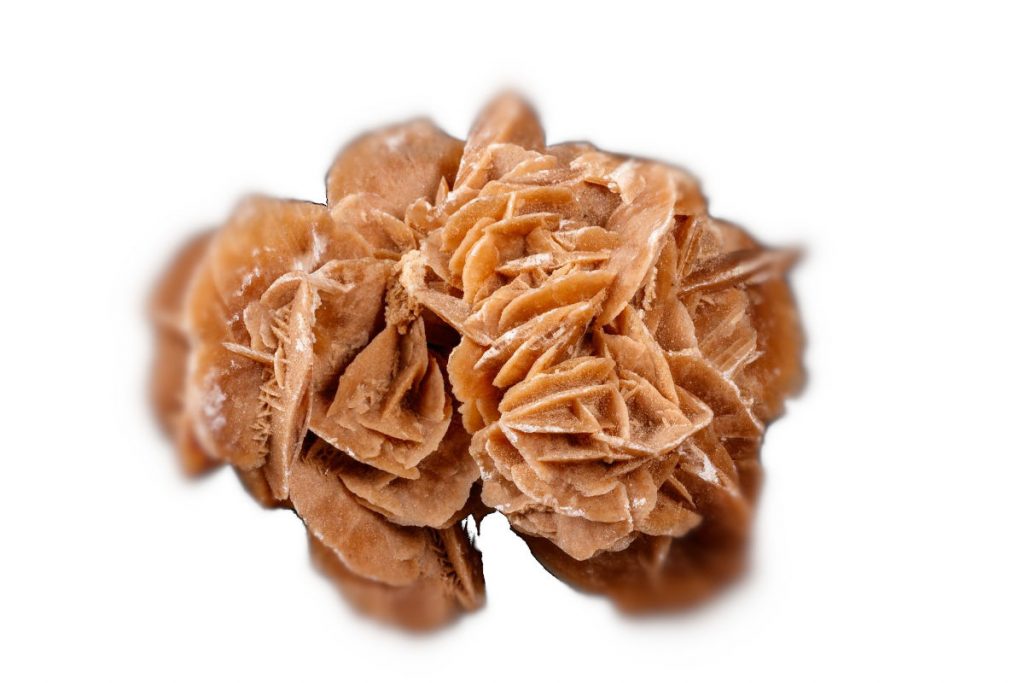
Where is Giethoorn located?
Geithoorn village is in the Northeast part of the Netherlands in the province of Overijssel within the De Wieden nature reserve and just 35 km (21.8 mi) north of Zwolle.
We made a Google Map that we share with you. This is our The Netherlands: Epic 10 Days for Perfect Itinerary Road Trip with Maps where you can easily navigate to Giethoorn.
Here is a few distance & time practical info:
-
- Zwolle: 35 km (21.8 mi) south of Giethoorn, 35 minutes drive
- Amsterdam: 120 km (74.5 mi) southwest of Giethoorn, 1 hour 20 minutes drive
- Rotterdam: 185 km (115 mi) southwest of Giethoorn, 2 hours drive
- Groningen: 90 km (56 mi) northeast of Giethoorn, a 1-hour drive
If you click this link and make a purchase, we earn a commission at no additional cost to you.
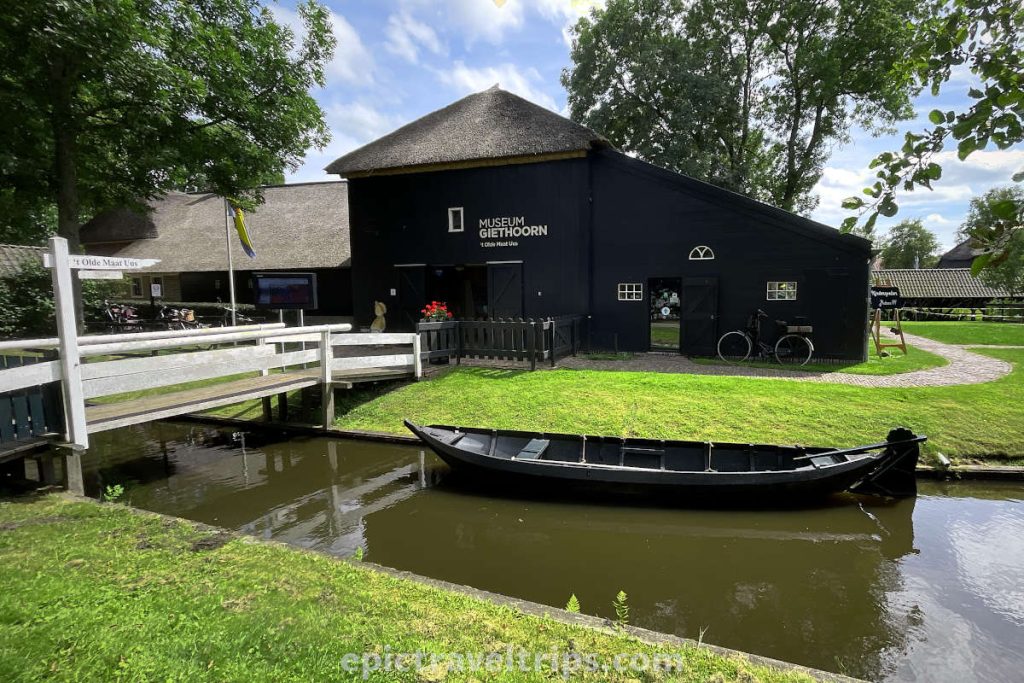
How To Reach Giethoorn?
The car is the best option. Interestingly enough while I was driving I notice no signs for the speed limits until I spotted small signs close to the ground. These small signs label the road number (N334) and on top is the small sign for the speed limit. We do not know why is done like this but it was an interesting difference to notice.
By car: We drove from our previous visiting spot Fort Bourtange and came by road N334. In the previous section, we listed driving times and distances from several cities in the Netherlands. On the roadside was a channel with many boats cruising, so maybe there is an option to come by boat as well.
Road N334 is the same coming from either North (Steenwijk) or South (Zwolle).
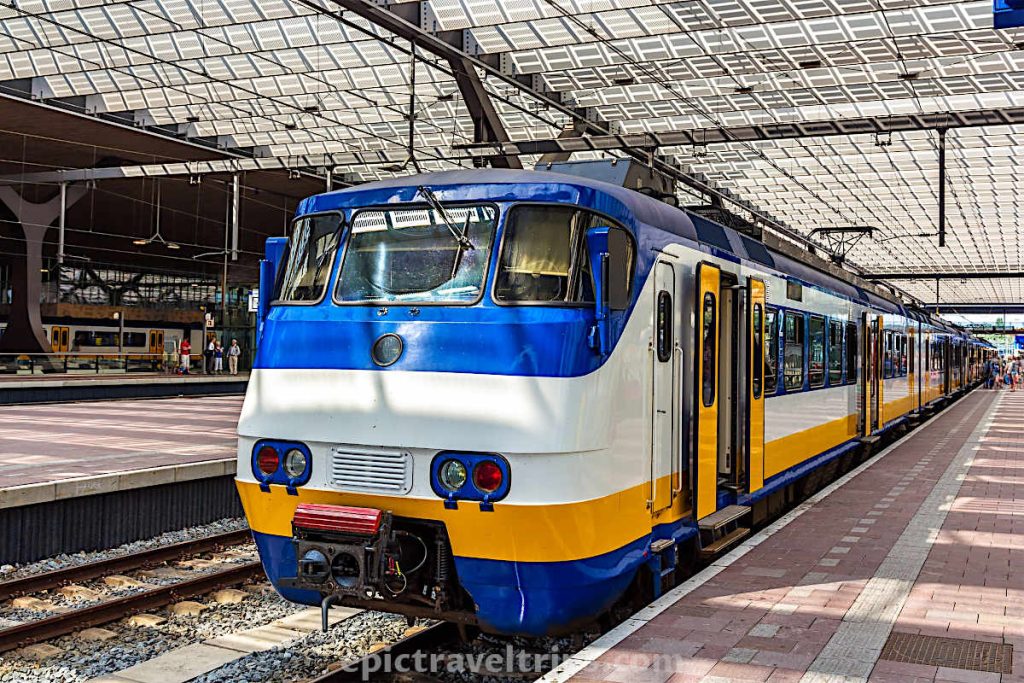
By train: Giethoorn village is not on a national railway network map. However, there are trains from Amsterdam to Zwolle or Steewijk. From there you can switch to buses to reach Giethoorn. It takes around 2h 15 min to reach Giethoorn from Amsterdam.
By bus: There is bus line 70 between Steenwijk and Zwolle (via Zwartsluis) that stops at Giethoorn. The ride takes around 10 minutes from either side.
We made a Google Map that we share with you. This is our The Netherlands: Epic 10 Days for Perfect Itinerary Road Trip with Maps where you can easily navigate to Giethoorn.

How Long Does It Take Giethoorn To Visit?
We spent 4-5 hours in Giethoorn village. It is worth mentioning the following. Giethoorn suddenly becomes almost empty after 17:00. The boats stop running, so the channels become empty. Make sure you arrive early enough to have time to enjoy a boat cruise, walk around, and visit the local museum. However, if you want to have a walking tour for yourselves, it is ok to stay longer or come later.
Where To Park For Giethoorn Visit?
Giethoorn village has three parking zones red South (Zuid), green Center (Centrum), and yellow Middle (Midden).
We made a Google Map that we share with you. So you can easily navigate attractions, parking lots, and boat tours in Giethoorn.
South (Zuid) – Red Parking Shields
The South parking lots are on the right-hand side if you are driving from the south (Zwolle, Meppel, or Zwartsluis direction) and labeled red as P1, P2, etc. All of them are free of charge. P1 has 100 spots, P2 has 160, P3 has 110, P4 has 130, P5 has only 60, P6 is even smaller only 50, and finally P7 has 100 spots.
P1 – Red
Near Rondvaart Zuideinde boat tour agency.
Address: Maaiensteeg 1, Giethoorn, Netherlands
Capacity: 100
Walking time to the center: 20 minutes (1.5 km – 0.95 mi)
Headroom: No limit
Opening hours: 24 hours
Rates: Free
Charging Station: No
P2 – Red
Near Smit Giethoorn Hotel & Restaurant & Boat rental.
Address: Zuiderpad 58, Giethoorn, Netherlands
Capacity: 160
Walking time to the center: 22 minutes (1.8 km – 1.1 mi)
Headroom: No limit
Opening hours: 24 hours
Rates: Free
Charging Station: No
P3 – Red
Near Smit Giethoorn Hotel & Restaurant & Boat rental.
Address: Zuiderpad 52, Giethoorn, Netherlands
Capacity: 110
Walking time to the center: 22 minutes (1.8 km – 1.1 mi)
Headroom: No limit
Opening hours: 24 hours
Rates: Free
Charging Station: No
P4 – Red
Near Pancake House and Restaurant De Witte Hoeve.
Address: Zuiderpad 32, Giethoorn, Netherlands
Capacity: 130
Walking time to the center: 20 minutes (1.5 km – 0.95 mi)
Headroom: No limit
Opening hours: 24 hours
Rates: Free
Charging Station: No
P5 – Red
Near Arendshorst bike, boat, and cruise rental.
Address: Beulakerweg 169B, Giethoorn, Netherlands
Capacity: 60
Walking time to the center: 20 minutes (1.6 km – 1.0 mi)
Headroom: No limit
Opening hours: 24 hours
Rates: Free
Charging Station: No
P6 – Red
Address: Beulakerweg 169, Giethoorn, Netherlands
Capacity: 50
Walking time to the center: 15 minutes (1.2 km – 0.75 mi)
Headroom: No limit
Opening hours: 24 hours
Rates: Free
Charging Station: No
P7 – Red
Near Restaurant Rondvaartbedrijf.
Address: Beulakerweg 167, Giethoorn, Netherlands
Capacity: 100
Walking time to the center: 20 minutes (1.6 km – 1.0 mi)
Headroom: No limit
Opening hours: 24 hours
Rates: Free
Charging Station: No
Center (Centrum) – Green Parking Shields
The Center parking lots are obviously in the center and you need to turn right coming from the south or left coming from the north. After 50 meters, for the green P1 parking, you turn left but for P2 & P3 parking you turn right and follow the road. P1 and P2 are free of charge but P3 is €4 per day. In total, they have 610 parking spots. P2 is closest to the main area but fills the first. We decided to park at P1 so we are close to the info center and boat tours.
P1 – Green
P1 is close to Plus grocery shop, bicycle, canoe, and boat rental, tourist info, restaurants, bars, hotels, B&B, and Camping.
Address: Eendrachtsplein 4, Giethoorn, Netherlands
Capacity: 250
Walking time to the center: 9 minutes (800 m – 0.5 mi)
Headroom: No limit
Opening hours: 24 hours
Rates: Free
Charging Station: Yes
P2 – Green
P2 is the closest to the center and near bicycle, canoe, and boat rental, nearby restaurants, bars, museums, tourist shops, campsites, and B&B.
Address: Dominee T.O. Hylkemaweg 39, Giethoorn, Netherlands
Capacity: 160
Walking time to the center: 4 minutes (300 m – 0.2 mi)
Headroom: No limit
Opening hours: 24 hours
Rates: Free
Charging Station: Yes
P3 – Green
P3 is very close to the center and near bicycle, canoe, and boat rental, nearby restaurants, bars, museums, tourist shops, campsites, and B&B.
Address: Bartus Warnersweg 50, Giethoorn, Netherlands
Capacity: 200
Walking time to the center: 6 minutes (450 m – 0.28 mi)
Headroom: No limit
Opening hours:
Rates: €4 per day
Charging Station: No
Middle (Midden) – Yellow Parking Shields
The Middle parking lots are on the left-hand side if you are driving from the north (Steenwijk direction) and are labeled yellow P1 and P2. When you turn left you have to drive for some time and eventually, you will see the sign to turn right. First comes smaller P2 with 40 parking spaces (free of charge) and further down the narrow road is P1 with 260 parking spaces (€4 per day charged).
P1 – Yellow
Near ‘t Vonder Café-Restaurant.
Address: Binnenpad 14, Giethoorn, Netherlands
Capacity: 260
Walking time to the center: 6 minutes (500 m – 0.3 mi)
Headroom: No limit
Opening hours: 24 hours
Rates: € 4 per day
Charging Station: Yes
P2 – Yellow
Near La Piccola Venezia Restaurant.
Address: Binnenpad 3, Giethoorn, Netherlands
Capacity: 40
Walking time to the center: 9 minutes (750 m – 0.47 mi)
Headroom: No limit
Opening hours: 24 hours
Rates: Free
Charging Station: Yes
Giethoorn Parking Summary
In our opinion, P2 green in the center is the best and the closest to the channels and the most activities. P1 Green in the center is good if you want to grocery shop, get tourist info, or take boat tours. The yellow middle parking spaces are not desirable for me since the last part needs to be driven on the narrow street close to the inhabitants’ houses. Of the red ones probably P7 is the best and closest to the center.
If you click this link and make a purchase, we earn a commission at no additional cost to you.

When Is The Best Time To Visit Giethoorn?
Giethoorn is open all year round. We visited in July on Sunday afternoon and had nice weather with a little bit of wind on the lake and lots of people visited the village on that day.
Best Day Of The Week
Based on our research here is what we have found. Regarding the day of the week, weekends (Saturdays & especially Sundays) are the busiest. Monday is the least crowded of working days and as the weekend approaches the visitor’s number progresses each day.
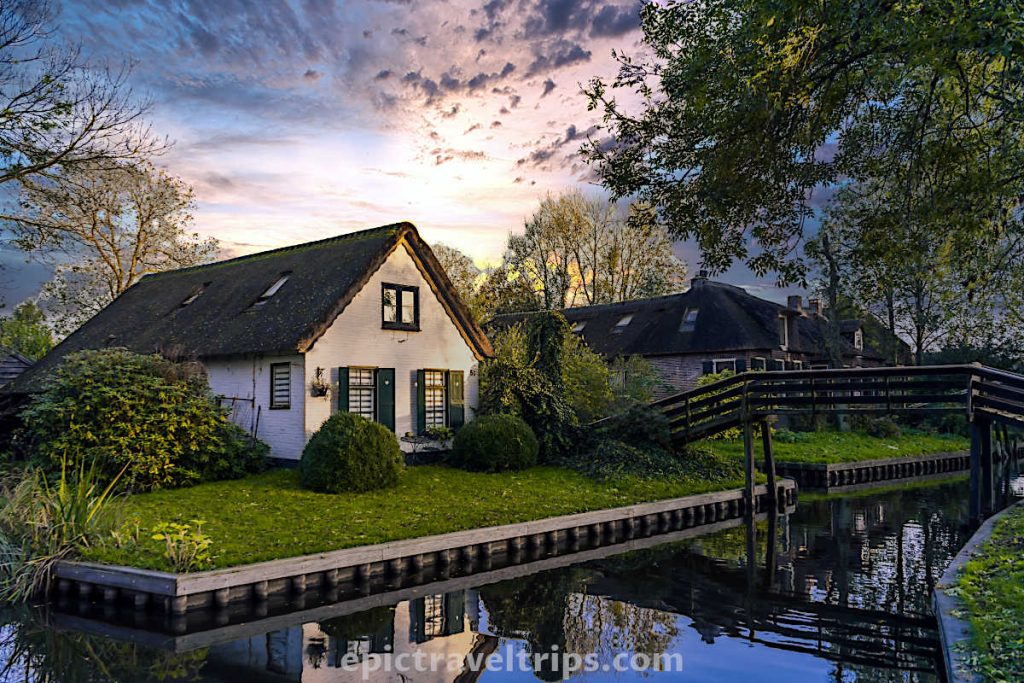
Best Hours Of The Day
When we asked the tourist office clerk when the best time during the day to visit Giethoorn is. We got the usual answer “It depends.”. However, she said that most tourist arrives between 10-11 AM. If we want to have a Giethoorn for ourselves with less crowd the best option is to arrive early around 08 AM or came late after 05 PM when boats stop floating and almost no one is on the channels a few pedestrians are on the streets.
We were really surprised that after 17:00 Giethoorn becomes like a “ghost” village compared with the buzz during the day or just one hour earlier.

Best Month Of The Year – Giethoorn Seasons
Based on many photos we found on the internet, every season has its charm. So if you want predominantly green colors come in Spring (April & May). If you want to see Giethoorn green with colorful flower gardens come in Jun, July, and August. Yellow Giethoorn is of course in Autumn (end of September and October). White Giethoorn with frost, snow, and ice for skating is during winter in December, January, and February.
Peak Season
Most Dutch families take a vacation during the Dutch summer school holiday (between mid-July to the end of August) and this is considered as peak season.
However, we saw a few videos on YouTube of visits during winter when some people skate on the frozen channel waters. Maybe Christmas time is not a bad idea to visit it.
If you click this link and make a purchase, we earn a commission at no additional cost to you.

Where To Eat?
Many places along the channels offer different dining and refreshing options. If you like to try something typical Dutch then go for a Kibbeling, fried fish pieces with fries, salad, and sauces. Note Kibbeling is served in punt-boat-shaped cardboard trays and sauces as side dishes as well.
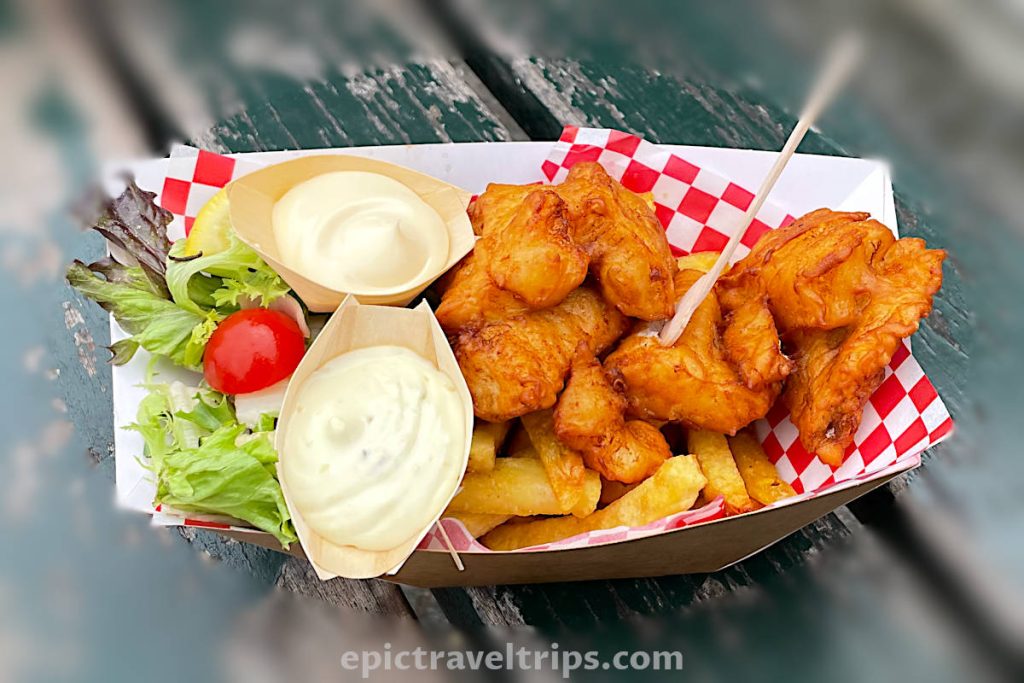
If you are on a budget then go to Plus grocery shop and buy fruit or pastries. We stopped first by the Geythorn restaurant to eat. However, we were surprised that the kitchen was already closed and it was around 16:00 on Sunday. So we walked away to the next spot at Grachthof restaurant. Of course, the first question was whether the kitchen is open. Luckily it was.

After we order our meals and waited for the dishes to arrive at the other table a couple wanted to pay. When the waitress asked about their meals one of them mentioned that it was too sweet. The waitress’s reply stunned us. She said: “It is good that was sweet it is better sweet.” We realized that we are stuck but had no way back. For the three of us, we paid €77 for our dinner. Fish & Cheaps and Burger were €17.50 each. Entrecote beef was €27.50. It was good for survival mode and nothing more.
On the other hand, the service was to paraphrase the famous quote “Cannot complain” from Italian tennis journalist Ubaldo Scanagatta to Novak Đoković into “Do not complain”. To conclude we cannot recommend any place from personal experience.
Where To Stay?
We decided to book a small house one hour from the Giethoorn so we can explore a larger area of Holland for the next two days. So we do not have a personal experience with the accommodation in the village.
We stayed in this lovely thatch roof bungalow near Ermelo as our base for exploring Giethoorn, Zaanse Schans Windmills, Amsterdam, Volendam, and Marken village.
If you click this link and make a purchase, we earn a commission at no additional cost to you.
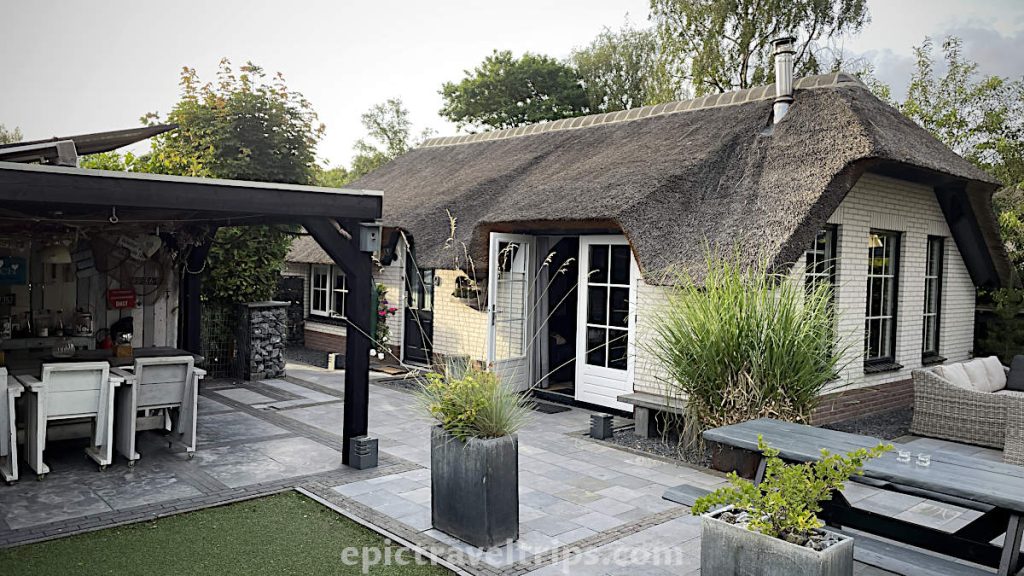
What Is Nearby Giethoorn?
When we say nearby we think more about what is in the distance around a 1-hour drive from Giethoorn and not exactly in its vicinity.
All the suggestions on our list were part of The Netherlands: Epic 10 Days for Perfect Itinerary Road Trip with Maps.
We made a Google Map so you can follow our road trip and easily plan yours.
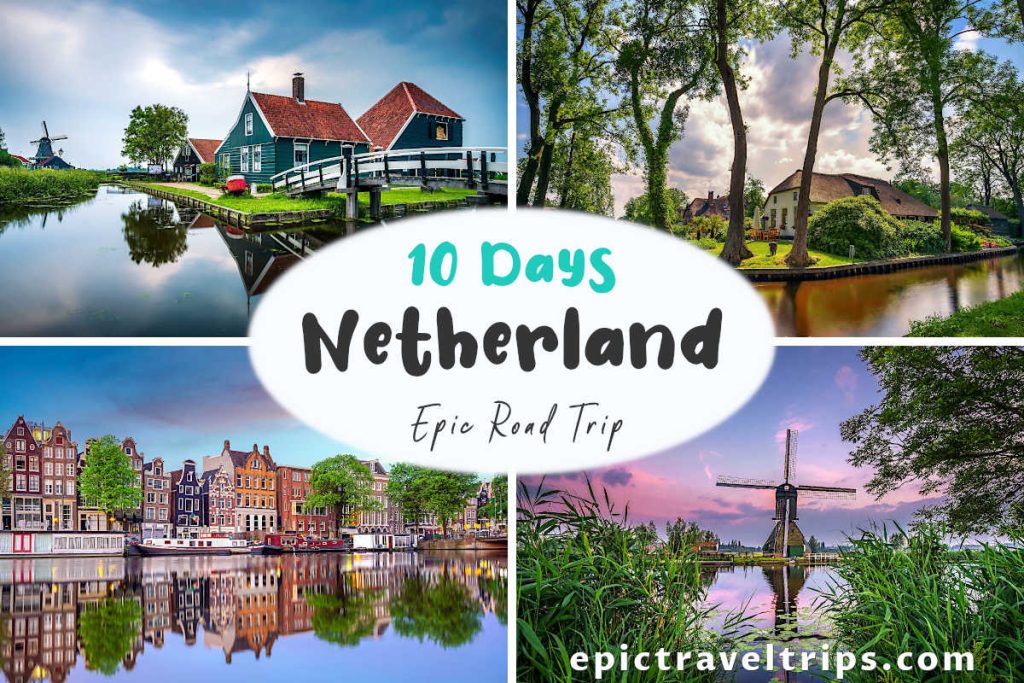
Amsterdam
Amsterdam is a must-see destination when visiting The Netherlands. Life on the canals, rich city architecture, tall narrow brick buildings in the row, and exciting day and nightlife are just a few reasons why many tourists visit Amsterdam.
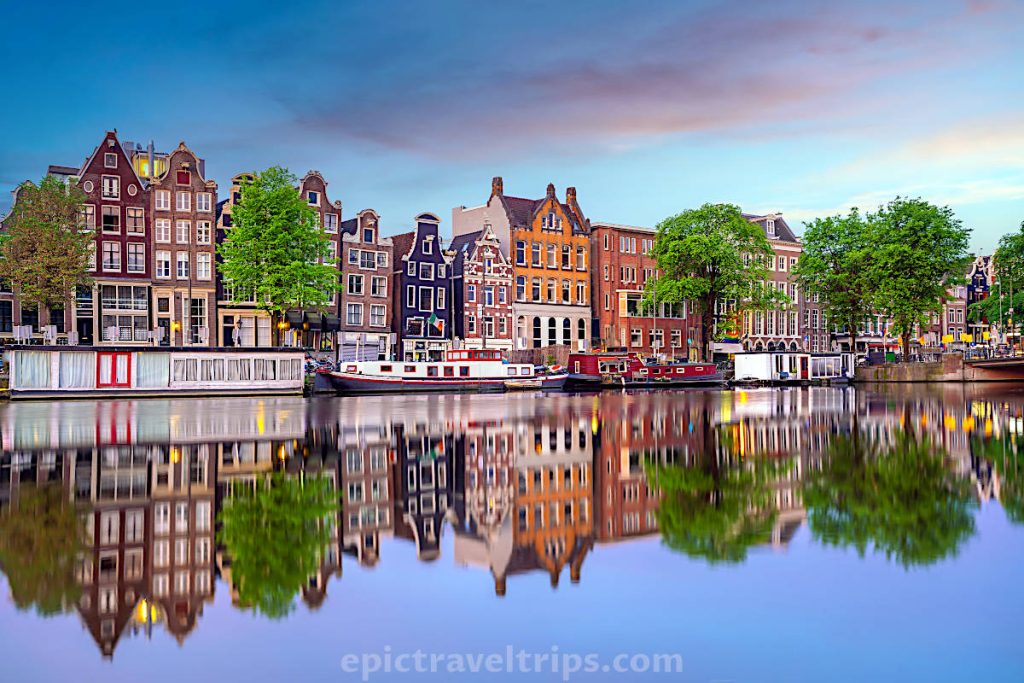
Volendam & Marken Village
Volendam and Marken are two picturesque villages and our next stops on our road trip through the Netherlands. They are not so close to Giethoorn but rather an excellent option as a day trip from Amsterdam and are often visited together. The villages are known for their colorful wooden houses, drawbridges, and picturesque corners.

Fort Bourtange
Fort Bourtange was a destination we came from to Giethoorn. It is on the German-Dutch border but not close to Giethoorn. The village is 130 km (80 mi) and 1h and 30 minutes drive from the fort. However, it is an important historical heritage and legacy of Holland.

Giethoorn – Our Impressions
Geithoorn is a unique place, and we would love to come back and see it at least once more. Even we might consider coming during Christmas, provided were some events during these holidays.
We take into consideration the fact that the village can be overcrowded during the mid-day. But, if we stay after 17:00, then Giethoorn will be empty.
One change would be to consider bringing our food and having a picnic near the lake.
We made a Google Map so you can follow our 10 days on The Netherlands Epic Road Trip.
We wish you an epic trip!


